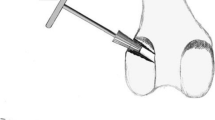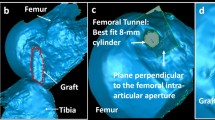Summary
The purpose of the study is to establish data on the stability of an ACL replacement. In 40 human cadaver knees, either a mid patellar ligament third with a trapezoid bone block on one side was fixed on the femoral side in a 2-diameter drill hole, or a conventional interference screw fixation was applied. Average primary stability amounted to 570 N (± 100 N) for the bone-blocking technique, and to 402 N ( ± 79 N) for the interference screw fixation. When statistically tested by variance analysis, stability was significantly higher for the bone blocking technique than with interference screw fixation (p < 0.05). Thus, when using a mid-patellar ligament third for ACL reconstruction, the new implant-free technique described here appears to be a practical and reliable method for femoral graft fixation.
Zusammenfassung
Ziel der Arbeit ist die Bestimmung der Primärstabilität eines neuen Verfahrens zur implantatfreien Verankerung eines Lig.-patellae-Transplantats beim vorderen Kreuzband (VKB-)ersatz. An 40 Kniegelenkpräparaten wurden mittlere Patellarsehnendrittel mit einer neuen Knochenverblockungstechnik in einem zweistufigen Bohrkanal bzw. mit konventioneller Interferenzschraubentechnik femoral fixiert. In der Universalprüfmaschine wurde die durchschnittliche primäre Ausrißfestigkeit mit der Knochenverblockung mit 570 N bestimmt ( ± 100 N), diejenige der Interferenzschraubenfixation mit 402 N ( ± 79 N). Die Varianzanalyse der paarweise ermittelten Daten ergab bei einem Signifikanzniveau von p < 0,05 eine signifikant höhere Primärstabilität der knöchernen Verblockung im Vergleich zur Interferenzschraubenfixation. Die Primärstabilität der Knochenverblockung liegt damit auf oder über dem Niveau anderer Techniken. Wählt man das Lig.-patellae-Transplantat, so stellt die hier untersuchte implantatfreie Verblokkungstechnik mit dem zweistufigen Bohrkanal eine geeignete und praktikable Methode im Spektrum der Möglichkeiten zur stabilen femoralen Transplantatverankerung beim VKB-Ersatz dar.
Similar content being viewed by others
Author information
Authors and Affiliations
Rights and permissions
About this article
Cite this article
Kühne, JH., Fottner, M. & Plitz, W. Experimental stability of a new implant-free fixation technique in ACL replacement. Unfallchirurg 102, 791–796 (1999). https://doi.org/10.1007/s001130050482
Published:
Issue Date:
DOI: https://doi.org/10.1007/s001130050482




